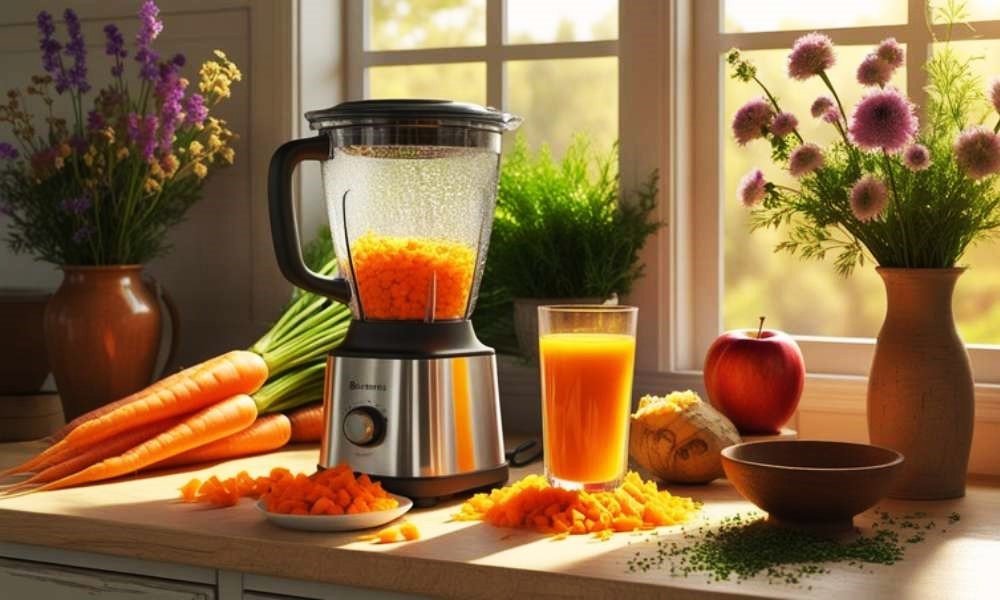Learning how to make carrot juice in a blender is one of the simplest and most rewarding skills for beginner gardeners and health-conscious home cooks. With just a few fresh ingredients and no need for a fancy juicer, you can transform your homegrown carrots into a naturally sweet, vitamin-packed drink. Whether you’re sipping it on a sunny morning or using it as a nourishing pick-me-up after a day in the garden, carrot juice offers pure, garden-to-glass refreshment with every pour.
Step 1: Gather Your Ingredients and Tools
Before starting, collect everything you need:
Ingredients:
- 4 to 6 medium carrots
- ½ cup water (optional)
- Optional add-ins: 1 small apple, 1-inch fresh ginger, half a lemon
Tools:
- Blender
- Vegetable brush or scrubber
- Knife and cutting board
- Fine mesh strainer or cheesecloth
- Large bowl or pitcher
- Glass jar or bottle for storage
Having your materials ready makes the process smooth and enjoyable.
Step 2: Choose and Prepare the Carrots
Select the best carrots.
Freshly picked garden carrots are ideal—look for firm texture, deep orange color, and vibrant green tops. If you’re using store-bought carrots, check that they’re not rubbery or faded.
Wash thoroughly.
Use a vegetable brush under cold water to remove dirt and soil, especially around the top and tip where grit can collect. If your carrots are homegrown, this step is essential.
Peel (optional).
Peeling is a personal choice. The skin contains nutrients but can add bitterness. If your carrots are young and clean, you can leave the peel on. For smoother, sweeter juice, peeling is recommended.
Chop into small pieces.
Cut your carrots into 1-inch chunks. This helps the blender work more efficiently and prevents overloading the blades.
Step 3: Blend the Carrots
Add to the blender.
Place the chopped carrots into the blender jar. If you’re including extras like apple or ginger, add them now.
Add a splash of water (if needed).
Start with about ¼ to ½ cup of water to help the blades spin smoothly. You can increase this slightly depending on your blender’s power.
Blend until smooth.
Begin at a low speed and gradually increase to high. Blend for 1–2 minutes until the mixture becomes a thick, smooth puree. Scrape down the sides if necessary.
Step 4: Strain the Juice
Set up your strainer.
Position a fine mesh strainer or layer of cheesecloth securely over a wide-mouthed bowl or pitcher.
Pour and press.
Slowly pour the blended carrot mixture into the strainer. Use a spoon to press and extract as much liquid as possible. If you’re using cheesecloth, bring the corners together and twist firmly to extract every drop of juice.
Reserve the pulp.
Don’t throw the pulp away—it can be reused in baking, soups, or compost.
Step 5: Taste and Adjust
Sample the juice.
Take a small sip. If it’s too earthy, brighten it with a squeeze of lemon. If it’s too thick, stir in a bit more water or apple juice.
Add a dash of spice.
For an extra boost, try a pinch of cinnamon, turmeric, or cayenne for warmth and depth.
Step 6: Serve and Enjoy
Chill before drinking.
Carrot juice tastes best cold. Let it rest in the fridge for 20–30 minutes, or serve it over ice.
Garnish (optional).
Add a sprig of mint or a lemon wheel for visual flair and a hint of added flavor.
Step 7: Store the Leftovers
Use a clean glass jar or bottle.
Pour any leftover juice into an airtight container. Keep it in the refrigerator for up to 3 days. Stir or shake thoroughly before each use, as it’s natural for the juice to separate over time.
Freezing tips:
You can freeze carrot juice in silicone molds or small freezer-safe jars. Leave space at the top for expansion, and label with the date. Thaw overnight in the fridge when ready to drink.
Step 8: Clean Up Efficiently
Rinse immediately.
To keep your blender clean, add warm water halfway and a splash of dish soap right after use. Blend for 10 seconds and rinse clean.
Wash tools and strainers.
Clean mesh strainers thoroughly to prevent pulp buildup. Cheesecloth should be hand-washed or discarded if disposable.
Bonus Tip: Use the Pulp Creatively
Rather than discarding the carrot pulp, repurpose it by adding it to:
- Muffin batter or pancake mix
- Soups and stews for added fiber
- Veggie patties or falafels
- Garden compost to enrich your soil
Now you know how to make carrot juice in a blender from scratch. With just a handful of ingredients and a little preparation, you can turn your garden harvest into a wholesome, energizing drink that tastes as good as it looks.
Making a strawberry milkshake in a blender feels like a little moment of joy. Toss in sweet strawberries, a splash of milk, maybe a scoop of ice cream—and in seconds, you’ve got a creamy, refreshing hug in a glass.

